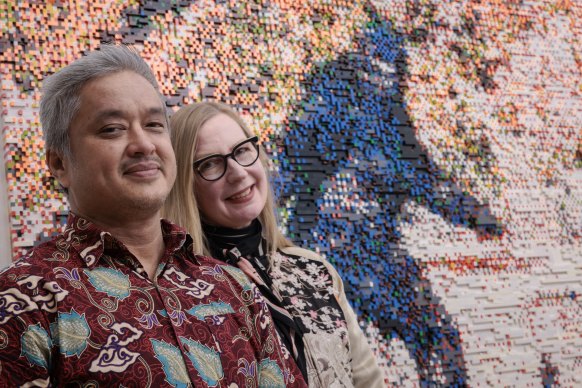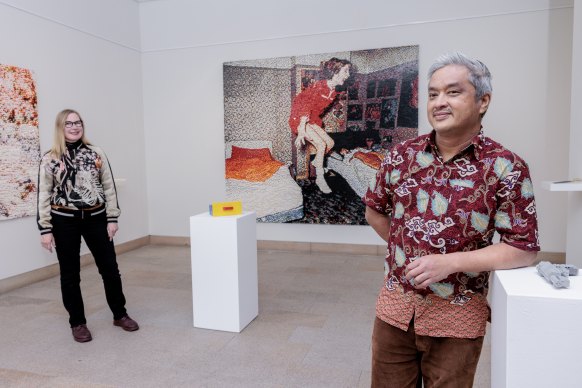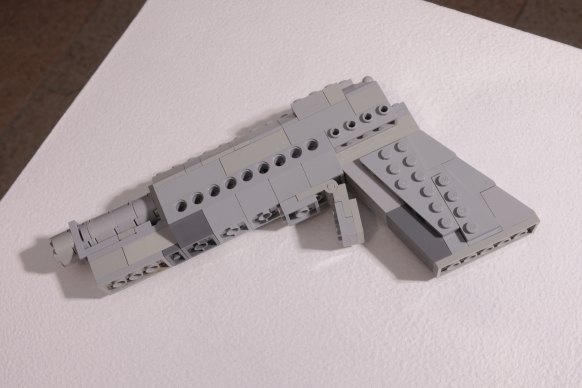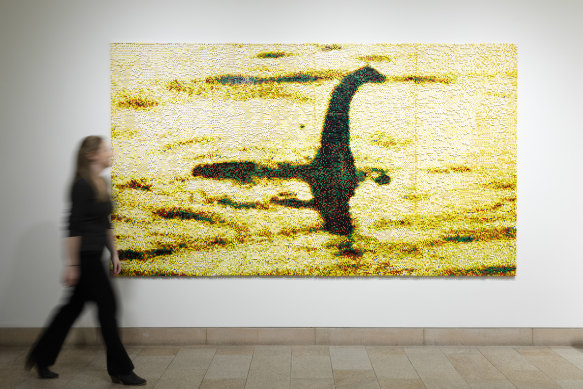Lenny Ann Low
In the middle of a gallery, in the centre of Sydney’s Chatswood, rests a collection of objects and images that resonate with people yearning to believe.
On one wall is Bigfoot, mid-stride on a dry creek bed in 1960s California. On another, the Loch Ness Monster peers from Scottish waters in 1933. There’s a fire extinguisher sculpture, bright red, mildly cartoonish, near a baseball bat that is slightly oversized and speckled with colour.

All are part of artists Claire Healy and Sean Cordeiro’s new exhibition The Persistence of Vision; The Sleep of Reason Produces Monsters, showing at Art Space on the Concourse.
Healy and Cordeiro won the 2022 Sir John Sulman Prize and represented Australia at the 53rd Venice Biennale in 2009.
The works for this new exhibition were made using Lego and, as noted in the exhibition program, combine “the diaphanous spectres of the past with the delusions of the near-present”.
“We’re looking at two different ideas of humans’ tendency to want to believe in something other than what is really there,” Healy says. “A comparison between the phantasm of the 1930s to the ’70s, and the present day where we’re looking at more dangerous phenomena.”
The latter is represented by sculptural renderings of improvised weapons used in the US Capitol riot on January 6. The other is Lego “paintings” of paranormal phenomena of the past including Bigfoot, the Loch Ness Monster and flying saucers.
All of the works delve into conspiracy theories, the unexplained, and the way many fervently believe in them. Once, photography carried an uncrushable air of truth.
Using Lego, Cordeiro and Healy have made frame 352 of a film taken in 1967 by Roger Patterson and Robert Gimlin, believed by some to be a female sasquatch striding through a Californian national park.
Another work recreates a famous image from the Enfield poltergeist happenings in London in the 1970s, where a girl in a red nightie is apparently being propelled from bed by supernatural forces.

“With photography, there was a tendency to think, ‘OK, well, that must be real’,” Healy says. “But, it’s not really about a photograph. It’s more about the theories that are built upon through more and more people supporting them.”
The array of improvised weapons used by rioters on January 6 at the US Capitol is a different take on the way beliefs can grow into truth.

“There’s a desk drawer, there’s a crutch, a helmet,” Healy says. “The way that they’ve been rendered is quite comical. It gives them an edge of being a little bit pathetic.
“The baseball bat, it’s got a bit of Fred Flintstone about it.”
Healy and Cordeiro fondly recall the mysterious phenomena books, movies and TV shows of their childhood including the 1970s to ’80s series Great Mysteries of the World (In Search of … in the US), hosted by skivvied Star Trek actor Leonard Nimoy.
“The beginning of that always used to scare the crap out of me because it was from Nosferatu,” Cordeiro says. “God, so scary.”
The pair were also big fans of publisher Usborne’s 1970s and ’80s kids book series The World of the Unknown, which explored ghosts, UFOs and monsters.
“We didn’t have any internet in those days so there were parts of the school library where you went ‘Oooh’,” Cordeiro says. “It was at that period of time when you’re figuring out how things have come together, the structure of life as we see it.
“It’s something very Gen X. The golden age of cryptozoology. And it aligns with the years of playing with Lego while growing up.”
It’s not the first time Healy and Cordeiro have used Lego to create work. In 2021, their exhibition Post-haste featured life-size Lego versions of a gorilla, a seal, a lion and a manta ray built into mass-produced wooden furniture.
For this exhibition, Healy and Cordeiro estimate they have used tens of thousands of Lego pieces. Most were donated or sourced second-hand.

“You can tell if you look closely at the works because there are scratches and dog teeth marks and the colours are discoloured or faded from sunlight,” Healy says.
They say the plastic bricks hark back to their childhoods, mirroring the pixilation of TV screens and the blurry nature of blown-up paranormal photographs
Cordeiro and Healy remain fascinated by humans’ interest in tall tales and furthering misinformation.
“I was reading Reddit the other day about this woman whose husband accidentally drilled a hole in his own leg,” Cordeiro says. “She said, ‘It’s red and angry’. Someone said, ‘You should put an onion on it’. Another said, ‘Don’t get a tetanus shot’.
“No, this dude is going to die of blood poisoning very soon. There are real-world ramifications for misinformation.”
Persistence of Vision is at Art Space on the Concourse until September 3.